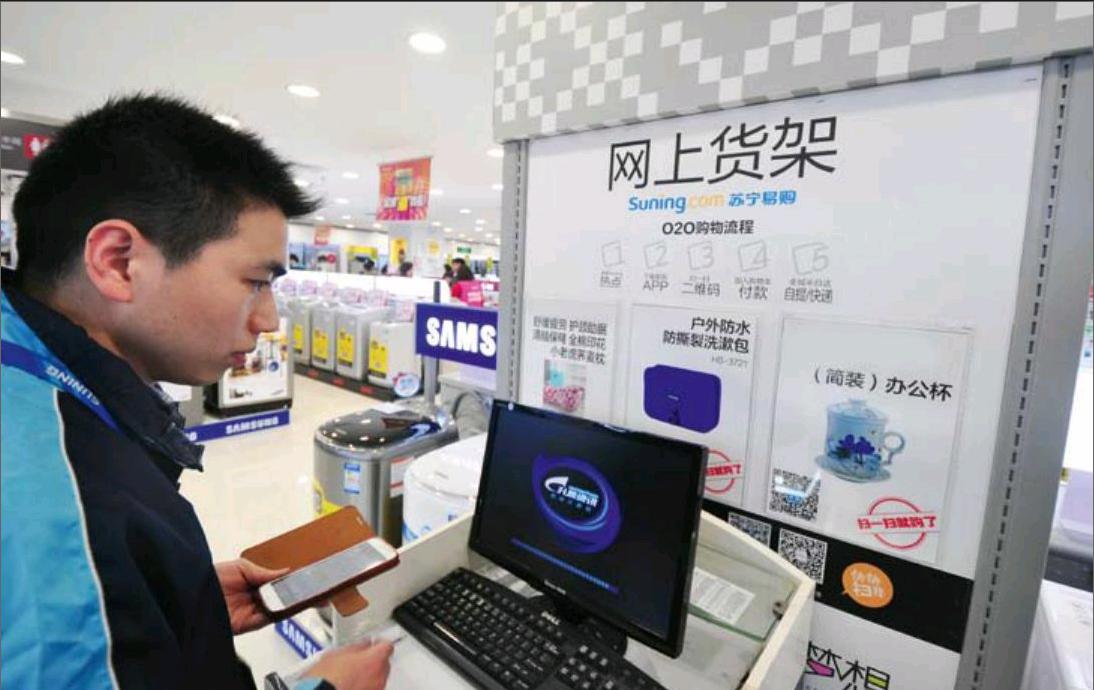Online to Offline
by+Zi+Mo

Two years ago, Wang Jianlin, chairman of leading Chinese real estate developer Wanda Group, made a wager with Jack Ma, executive chairman of the countrys largest e-commerce firm Alibaba, as they appeared jointly at a television awards ceremony. Ma bet that by 2020, online shopping would account for 50 percent of Chinas retail market. If his prediction proves accurate, the real estate billionaire will pay his tech counterpart 100 million yuan. If not, Ma will pay Wang the same amount.
Today, however, the boundary between online and offline retail has become increasingly blurred. Traditional home appliance retailers Suning and Gome have gone online, while e-commerce titans JD.com and YHD.com explore the online-to-offline(O2O) market.
O2O Test Field
In Taiyuan, capital of Chinas inland Shanxi Province, a “war” is raging between two e-commerce giants and their respective local allies. The city has become a beta O2O battlefield.
On April 17, Meetall supermarket chain, the largest of its kind in Taiyuan, joined hands with YHD.com to launch the YHD Meetall Flagship Store. JD.com was already working with the biggest local convenience store chain, Tangjiu, to promote its O2O strategy.
Why did the two e-commerce companies both choose Taiyuan to test their O2O strategies? Compared to top-tier cities like Beijing, Shanghai, and Guangzhou, inland Taiyuan lags behind in logistics conve- nience and local residents are less interested in online shopping. At the same time, Taiyuan boasts one of the countrys most developed convenience store networks. According to Convenience Store Index of Chinese Cities recently released by China Chain Store & Franchise Association, Taiyuan trails only Shenzhen and Dongguan of all Chinese cities in convenience store development.
Frequently, e-commerce giants drop prices low, sometimes below wholesale, to quickly expand their market shares. But this strategy isnt ideal for Taiyuan, especially for fast moving consumer goods. “The profit margins of fast moving consumer goods are often low,” explains Zhang Haoming, supervisor of O2O Sales and Operation at JD.com. “Revenue from each order is meager. If JD.com sells fastmoving consumer goods independently, gross profits wouldnt even cover delivery.”Moreover, two or three days are needed to ship orders from its Beijing warehouse to Taiyuan. For this reason, JD.com “married” Tangjiu for sales of fast moving consumer goods.
Yang Wenbin, chairman of Tangjiu, has been eyeing the e-commerce market for years. However, many attempts by traditional retailers have been unsuccessful.“The biggest problem is lack of consumer demand,” he explains. “I see e-commerce as a value-added service for our convenience stores. Consumer flow is the most important factor for retailers. Any service that can bring consumers into a convenience store helps, even if they just come to pick up deliveries.”

Initially, Yang only expected Tangjius cooperation with JD.com to bring more consumers to its stores. As their cooperation deepened, however, he realized that Tangjiu could use big data compiled by JD.com to focus on the highest-demand goods. “In this way, we can improve our supply structure according to the popularity of online shopping,” Yang declares.
Meanwhile, JD.com gets commission for goods Tangjiu sells through its e-commerce platform and acquires Tangjius consumer resources for free. Moreover, JD.com can incorporate the convenience store chains delivery network into its own logistics system, which is much more cost-efficient than building its own independently.
YHD.com and Meetall have also achieved mutually beneficial cooperation. With support from YHD.com, Meetall established a specialized warehouse in its logistics building. Goods ordered online via YHD Meetall Flagship Store are transported from the special warehouse to a Meetall supermarket nearest the buyer, where he or she can pick up the products. “We hope to optimize our industrial chain and blaze a new development road before traditional retail is crushed by ecommerce,” admits Chen Ruixue, head of Meetalls e-commerce division.
Bottleneck for E-commerce
Taiyuan is only one example of cooperation between e-commerce and traditional retail. More and more O2O cooperative projects are popping up throughout China. For instance, WeChat joined hands with Wangfujing Department Store and Rainbow Department Store, Alibaba Group took a stake in Chinese retail guru Yintai Group, and JD.com signed strategic cooperation agreements with China Resources Vanguard supermarket chain and Beijing Huaguan Shopping Mall. Even Chinas express delivery giant SF Express has set foot in the O2O market by establishing Heike community stores based on its e-commerce site SFbest.com and its logistics network.
Just a few years ago, traditional retailers couldnt wait to embrace e-commerce. However, with this O2O cooperation trend, e-commerce companies are the side pushing to join hands with offline channels. Why?
In recent years, web sales have continued growing, but few sites have achieved profitability. Instead, they look to seize market shares through price wars. Market share or profits? Many are contemplating the dilemma, which blurs the future of e-commerce in China. Moreover, as competition between retail sites becomes increasingly fierce, their major advantage over offline retailers, comparatively lower operational costs, disappears. The annual marketing costs of a mid-level online shop on Taobao.com can reach 1 million yuan. The figure has already reached the annual rental and labor costs of many brick-andmortar retailers. A survey conducted by Chinese market researchers shows that the per customer acquisition cost of Vancl, an e-commerce site specializing in clothing, is about 150 yuan, which is unimaginable for traditional retailers.
In addition to prices, consumers have paid greater and greater attention to the shopping experience on e-commerce sites. So far, e-commerce sites have met a bottleneck in attracting consumers. To break the bottleneck, they must expand the O2O market. “E-commerce sites O2O strategy should rely on cooperation with brick-andmortar stores,” opines Zhang Yi, CEO of iiMedia Research, a mobile internet market consulting company. “They need to change their inherent business ideas and modes, as well as consumers habits. Moreover, they should meet consumer needs for integration of online prices and offline services, thus fusing advantages of both online and offline shopping.”

